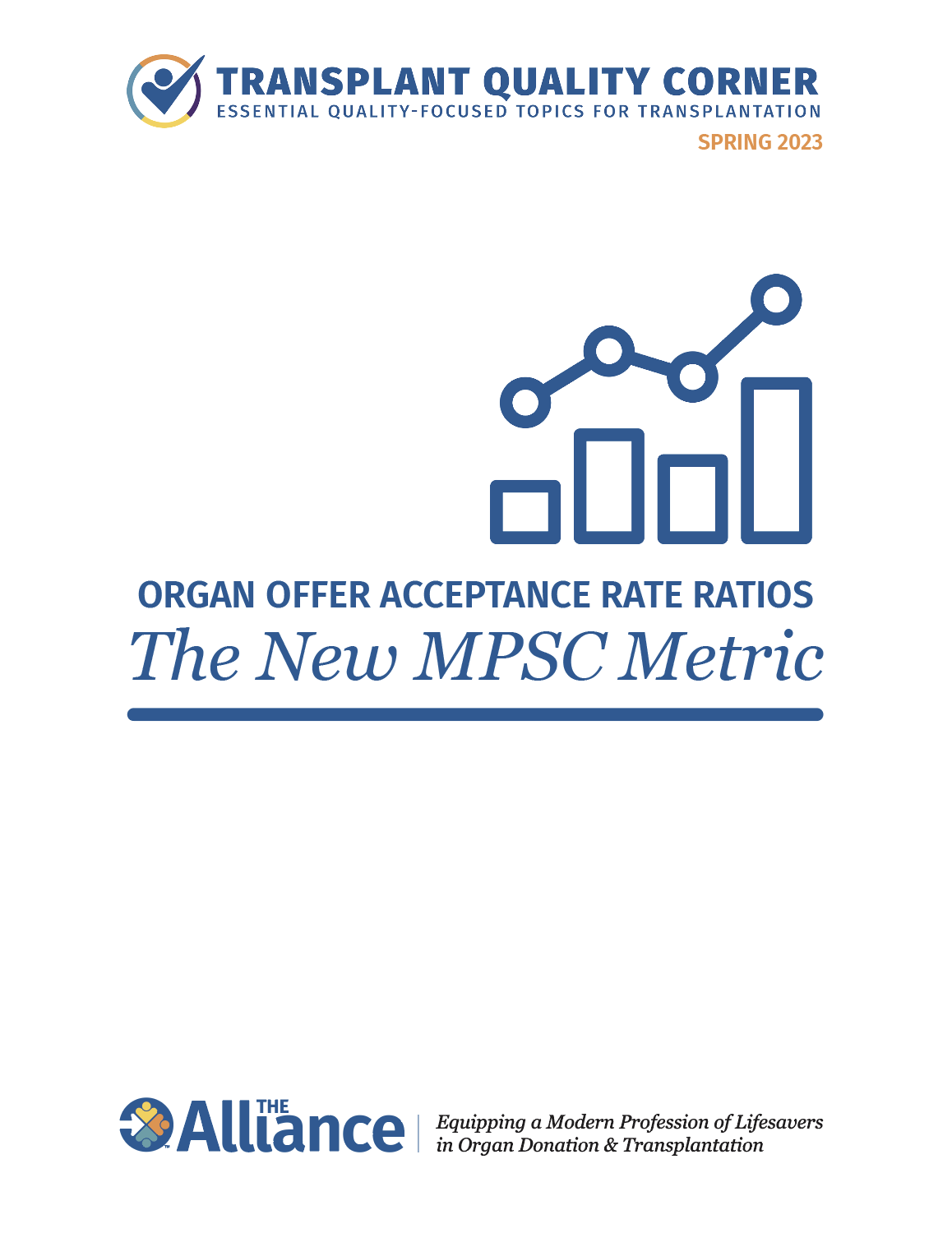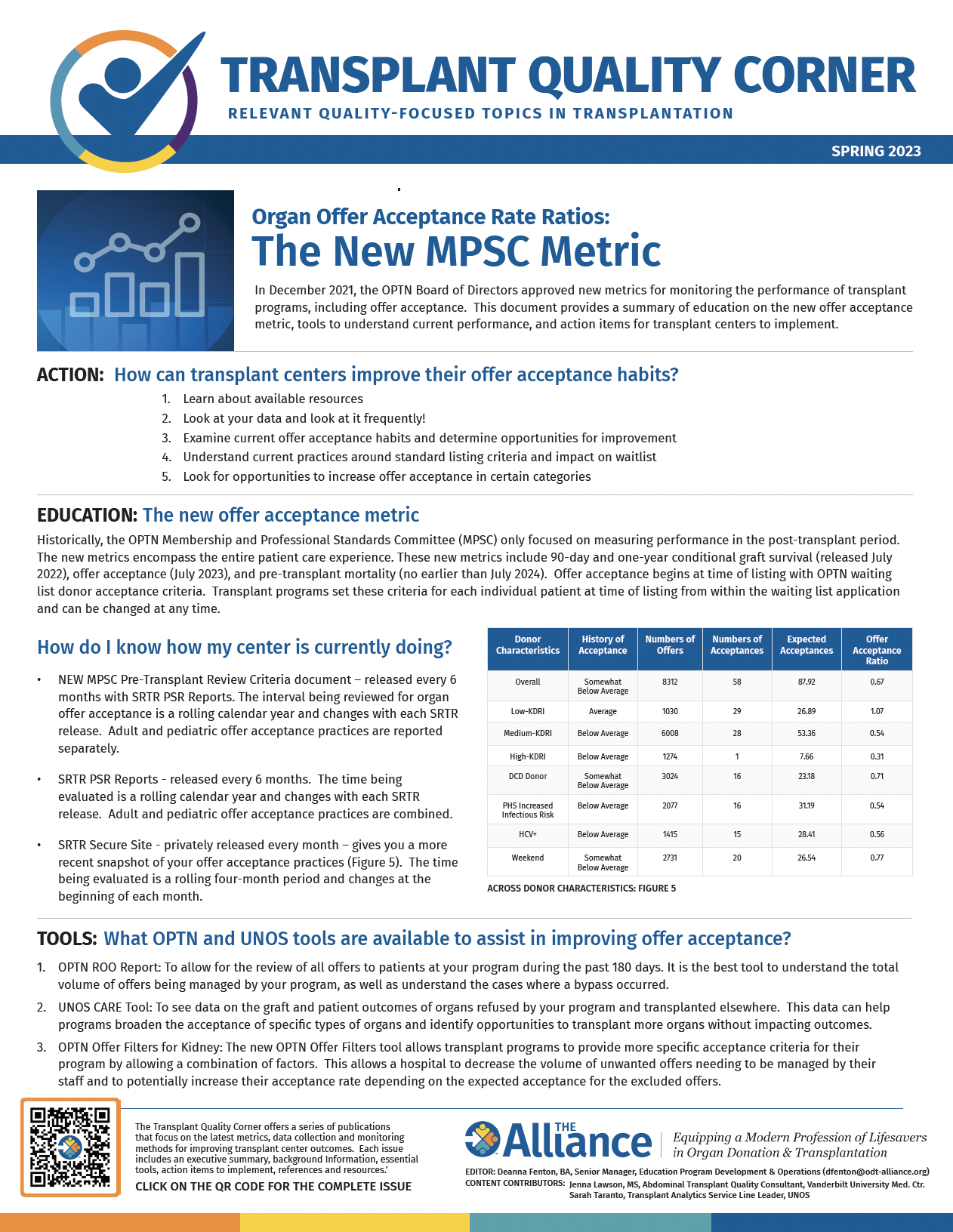The Alliance
Insight Series
The Alliance insight series offers critical resources for stakeholders across the donation and transplantation continuum. For each topic, you can find related action items, tools, and references.
SPRING 2023
IN THIS ISSUE
The Alliance Insight Series
Feedback & Suggestions Welcome
Your input is valuable to us as it helps improve our programs and offerings in order to provide you with vital updates and essential information. Please feel free to share your thoughts and ideas with us.

SPRING 2023

Executive Summary
In December 2021, the OPTN Board of Directors approved new metrics for monitoring the performance of transplant programs, including monitoring organ offer acceptance. This document provides a summary of education on the new offer acceptance metric, tools to understand current performance, and action items for transplant centers to implement.

Action
How can transplant centers improve their offer acceptance habits?
Five Opportunities to Improve Offer Acceptance
- Learn about available resources
- Understand the tools available to you and develop a plan to utilize them
- Select only those tools most helpful for your organization and use consistently
- Attend UNOS CARE User Group meetings to get ideas from other programs on how they are approaching the use of various tools
- Look at your data and look at it frequently!
- SRTR secure monthly site monthly “across donor characteristics“ table
- Trend over time
- Create an offer declined meeting to continually review your data
- Examine current offer acceptance habits and determine opportunities for improvement
- Be realistic about what your center will or will not accept
- Do a review of current offer acceptance, policies and protocols
- Create an offer declined meeting to continually review your data
- Understand current practices around standard listing criteria and impact on whitelist
- Review standard listing criteria and make sure physicians know where this is being documented in UNOS
- Especially with a large waitlist – standard listing criteria can lead to a lot of offer declines
- Offer acceptance is not equal to organ acceptance. All unique candidates who are offered and declined will count towards the metric
- By setting these criteria to the requirements for a specific patient, a transplant program, illuminates offers they would not accept for that specific patient. This reduces the number of declines impacting a transplant program
- Look for opportunities to increase offer acceptance in certain categories
- Waitlist review > not all candidates are going to accept all kinds of organs
- Examine categories, such as PHS, DCD, HCV, KDPI, donor age/location to identify good candidates for a hot list of patients willing to accept these donor organs
Education
Background
Historically, the OPTN Membership and Professional Standards Committee (MPSC) only focused on measuring performance in the post-transplant period. The new metrics encompass both the pre-transplant and post-transplant experience. These new metrics include 90-day and one-year conditional graft survival (released July 2022), offer acceptance (July 2023), and pre-transplant mortality (no earlier than July 2024). Organ offer acceptance begins at the time of OPTN listing by customizing individual candidate acceptance criteria. Transplant programs set these criteria for each individual patient at the time of listing from within the waiting list application and can be changed at any time. (Figure 1)
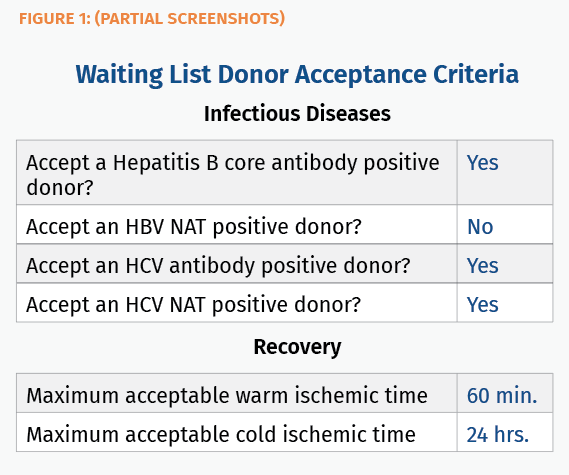
Breakdown of elements being reported
Number: the number of offers received during the evaluation period
- Includes only offers for organs that are eventually transplanted
- Excludes bypasses (such as those from Offer Filters or expedited placement), offers for organs that were not eventually transplanted, offers that occurred after final acceptance in a match run, duplicate offers of the same organ, and offers to multi-organ candidates (except KP candidates who are also listed for kidney alone).
- Offer acceptance does not equal organ acceptance. You can have multiple offer declines for the same organ
Observed events: total number of offers accepted
Expected events: expected number of offers to be accepted. This is risk-adjusted and considers things such as donor quality, candidate characteristics, position on the match run, and the distance of the potential recipient from the donor. Risk adjustment factors change with each SRTR release and can be found on the public SRTR website. [See Additional Resources for how to locate]
Hazard ratio (HR):
(Observed + 2) / (Expected + 2)
- HR > 1 = program accepts more offers than expected
- HR < 1 = program accepts fewer offers than expected
To monitor transplant centers’ performance, the MPSC developed performance thresholds for each of the new metrics.
“Identified for yellow-zone” indicates a program is in an area of performance improvement, and that program will receive a notice of this as well as an offer of assistance through the OPTN Individual Member Focused Improvement (IMFI) group (Figure 3).
“Identified for review” indicates a program is identified for mandatory MPSC inquiry. Centers are flagged if there is a greater than 50% probability of meeting the hazard ratio criteria (Figure 4).

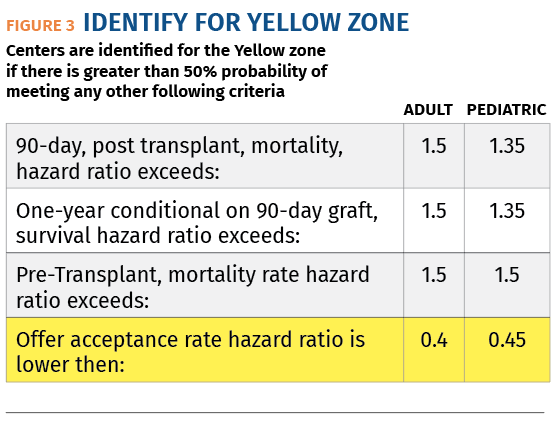
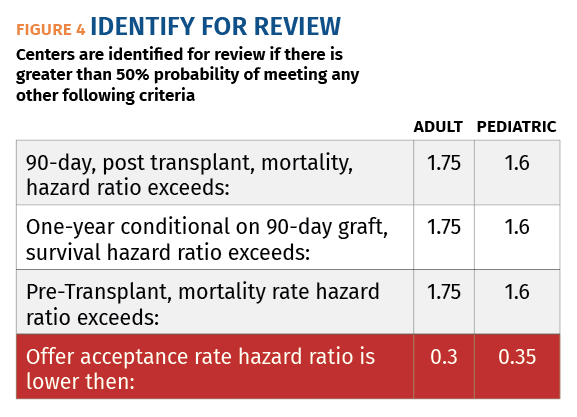
How do I know how my center is currently doing?
NEW MPSC Pre-Transplant Review Criteria document (Figure 2) – released every 6 months with SRTR PSR Reports. The interval being reviewed for organ offer acceptance is a rolling calendar year and changes with each SRTR release. Adult and pediatric offer acceptance practices are reported separately.
SRTR PSR Reports – released every 6 months. The time being evaluated is a rolling calendar year and changes with each SRTR release. Adult and pediatric offer acceptance practices are combined.
- Table B11 and Figures B10 – B14: Offer Acceptance Practices (Figure 5) – allows you to compare yourself to your OPO/DSA, region, and nation.
SRTR Secure Site – privately released every month and gives you a more recent snapshot of your offer acceptance practices (Figure 6). The time being evaluated is a rolling four-month period and changes at the beginning of each month. See Additional Resources for how to locate.
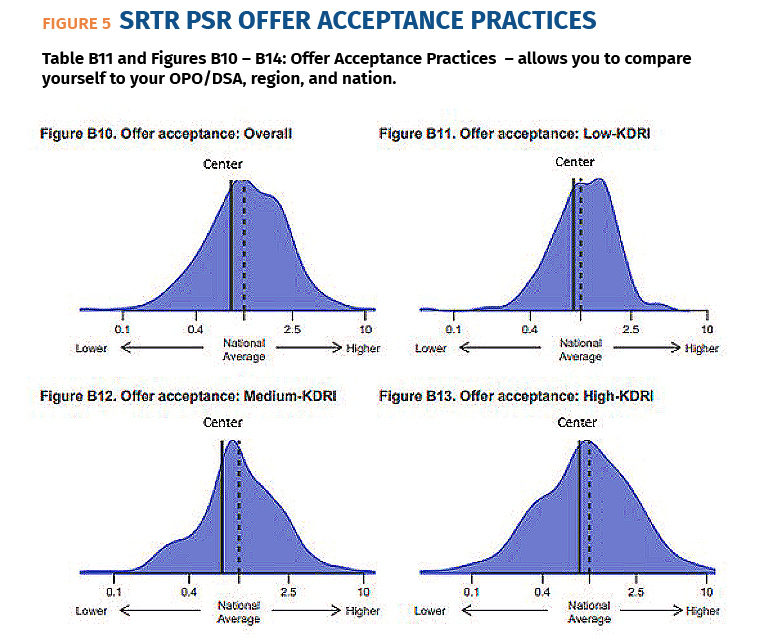
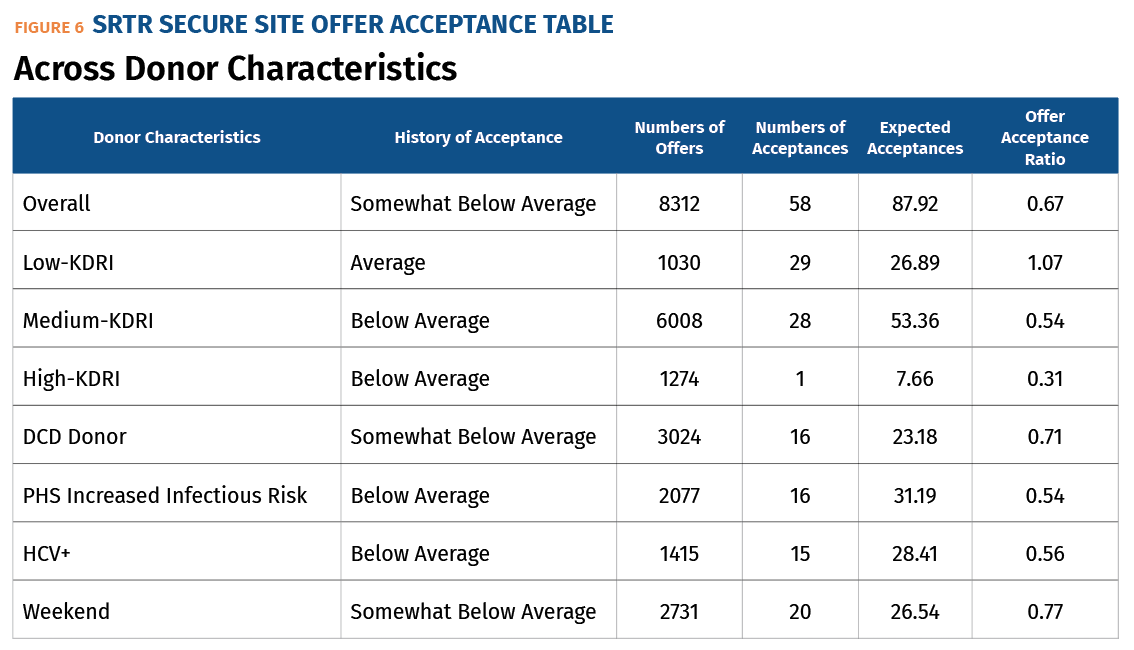
Tools
What OPTN and UNOS tools are available to assist in improving offer acceptance?
OPTN ROO Report
To allow for the review of all offers to patients at your program during the past 180 days. It is the best tool to understand the total volume of offers being managed by your program, as well as understand the cases where a bypass occurred. The weekly data are available as both an Excel spreadsheet of the raw data in the OPTN Data Files section of the Data Service portal (DSP), as well as in a Tableau dashboard (Figure 7) within the OPTN Visual Analytics section.
Figure 7: OPTN Organ Offers Report TXC/ROO Report
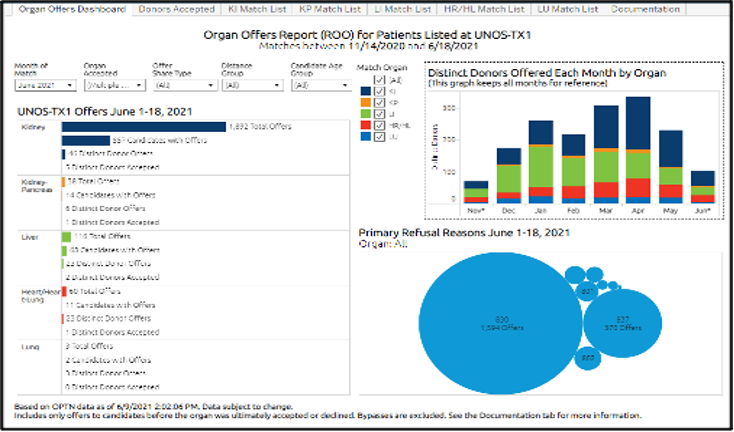
UNOS Care Tool
To see data on the graft and patient outcomes of organs refused by your program and transplanted elsewhere. This data can help programs broaden the acceptance of specific types of organs and identify opportunities to transplant more organs without impacting outcomes. The tool (Figures 8-9) is available to all UNOS member transplant hospitals and is found in the UNOS Visual Analytics section of the DSP. The report includes a review of all primary offers received by the transplant program during the past two years, excluding any matches not yet completed by the OPO, and is updated weekly.
Figure 8: CARE Tool Accept Tab

- Allows for filtering to only organs accepted and transplanted
- First visualization includes green bar of number of distinct donors offered during period, blue bar of number of those accepted by program, and red line of acceptance rate.
- Acceptance rate here is by donor offered to program, not individual patient offers.
Figure 9: CARE Tool OFFER Tab

- Filter to only organs declined by program but transplanted elsewhere
- Detailed data can be downloaded to Excel.
- Filter to specific donor or see all offers for a specified candidate during the period.
- Filter to individual refusal reasons.
- A unique feature is the ability to see the most recent outcomes reported by other transplanting programs on the TRR and six month/one-year TRFs.
OPTN Offer Filters for Kidney
The new OPTN Offer Filters tool allows transplant programs to provide more specific acceptance criteria for their program by allowing a combination of factors. For example, a hospital can indicate they wish to see offers of DCD organs, but only if they are under the age of 60 and if the donor is within 500 nautical miles of the transplant hospital and if the offer is prior to cross-clamp. This allows a hospital to decrease the volume of unwanted offers needing to be managed by their staff and to potentially increase their acceptance rate depending on the expected acceptance for the excluded offers.
In addition to this functionality, Offer Filters Explorer (Figure 10), found in the OPTN Visual Analytics section, applies Data Science techniques to historical data at each transplant program to identify recommended offer filters with the most potential impact on unwanted offers with few, if any, historically accepted organs impacted. Offer Filters Explorer allows you to review the impact of potential filters on historical data. You must navigate to the Offer Filters Manager application to set the filters for future offers.
Figure 10: Offer Filters Explorer

Additional Resources
How to access risk adjustment factors from the SRTR public website:
- Go to public SRTR website (www.srtr.org)
- Tools > Risk Adjustment Models > Offer Acceptance
- Choose organ of interest and model strata > click on “Model Elements Plots” tab and then download .csv file. This will show you which factors are risk adjusted for the candidate and donor, as well as the impact of each factor.
How to see most current offer acceptance habits on SRTR secure website:
- Go to secure SRTR site (https://securesrtr.transplant.hrsa.gov/home/)
- Reports > CUSUM Charts > Type: Offer acceptance
- Time period of offers is at the top right of both CUSUM charts
- “Across donor characteristics” table details overall offer acceptance ratio as well as the ratio for specific categories, including DCD, increased risk, and HCV+ offers
How to access OPTN ROO reports:
- Dashboard Tool
- Go to Data Services Portal in UNet
- OPTN Visual Analytics > Organ Offers Report TXC
- Select organ “Organ Accepted” and time period of interest “Month of Match”
- Excel Spreadsheet, download raw data file
- Go to Data Services Portal in UNet
- OPTN Data Files > Use Publication Title filter by typing “ROO” and hitting enter > Report of Organ Offers (ROO) > Click on report name to download file > Click on file name, should open in Excel
- Custom Report Builder
- Custom Report Builder > New Report > Select Data Source of Organ Offers
- Create your own report, documentation available in Documentation section of the Data Services Portal
We would like to express our sincerest gratitude for our contributors’ tireless efforts on making Transplant Quality Corner a reality. Their dedication and expertise have been an invaluable contribution to the successful launch of this project. We are incredibly grateful for all their hard work and commitment.
A SPECIAL THANKS TO THIS ISSUE’S CONTRIBUTORS
A SPECIAL THANKS TO THE TRANSPLANT QUALITY CORNER WORKGROUP
Feedback
If there is content you feel that should be added or was lacking, we would like to hear from you. Positive feedback on what is working for you, is also welcomed. Thank you for taking the time to provide us with your feedback.




